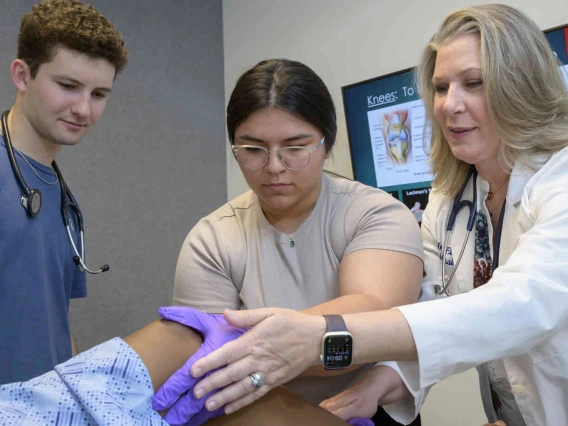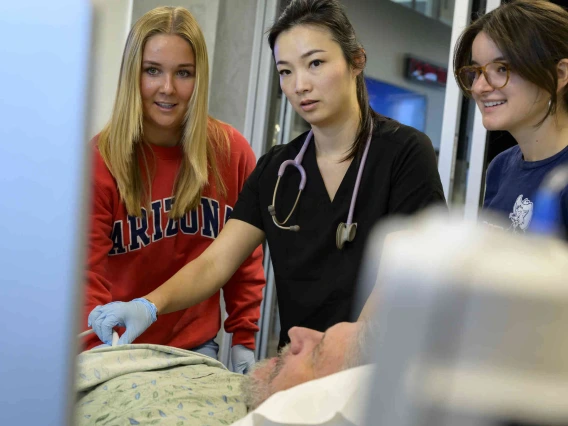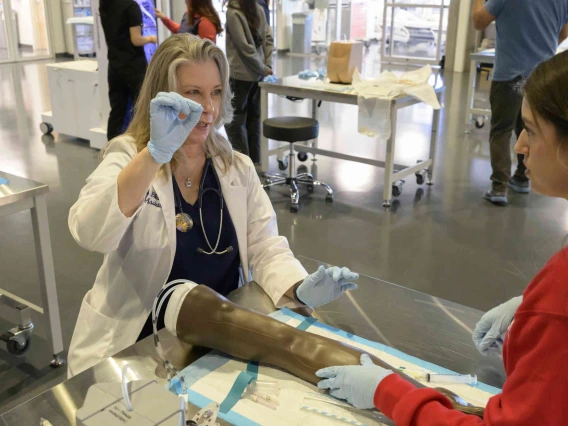Financial Aid and Scholarships
The are various requirements for receiving federal financial aid that determine the amount of aid a student will receive. Students apply for aid by completing the Free Application for Federal Student Aid (FAFSA) at fafsa.ed.gov. Eligible students receive financial aid funds at the beginning of each term.
The most relevant requirements for Master of Physician Assistant Practice (MPAP) students are to:
- Be admitted and enrolled at least half-time in coursework accepted for credit by the program.
- Be a U.S. citizen, U.S. national, or eligible non-U.S. citizen with a valid Social Security number (unless from the Republic of the Marshall Islands, the Federated States of Micronesia, or the Republic of Palau).
- Maintain satisfactory academic progress toward a degree.
- Use aid only for educational purposes.
- Not owe a refund on a federal grant or be in default on any federal educational loan. (Review Pell Grant and loan history at https://studentaid.gov.)
- Must attend all classes for which they enroll. Failure to attend class may result in the adjustment of aid.
Applying for Aid
To be considered for most types of aid, especially loans, you must submit a Free Application for Federal Student Aid (FAFSA).
- FSA ID:
Students, parents, and borrowers need an FSA ID made up of a username and password to access certain U.S. Department of Education websites. Your FSA ID will confirm your identity when accessing your financial aid information and electronically signing your federal student aid documents.
- Financial Information
- The FAFSA form requests various financial details, including information from tax documents and the balances of your savings and checking accounts. For the future 2026-27 application cycle (not open), you will need to supply data from your 2024 tax returns.
- Financial Aid Direct Data Exchange: Students and contributors must consent to:
- Disclose PII from the FAFSA form to the IRS for matching purposes.
- Obtain federal tax information from the IRS via direct data exchange.
- Allow the U.S. Department of Education to use, share, and reuse their federal tax information for determining and administering financial aid.
Failure to provide consent will result in ineligibility for federal student aid, even with manually entered tax information.
- Contributor: For Physician Assistant (PA) students, parent income is not required for federal aid, but a married student's spouse may be considered a contributor. If you filed taxes jointly, report your spouse's information without marking them as a contributor. If you filed separately, your spouse will be considered a contributor. Contributors can access their StudentAid.gov account by using their FSA ID (account username and password).
- Valid Email Address
- School Code
- The University of Arizona code is 001083. To change school codes, you must submit an online correction to your FAFSA.
If you plan to begin the PA Program in Fall 2026, you’ll need to complete the 2026–27 FAFSA, which is not yet available.
- FAFSA applications for a future academic year typically open around October 1. However, due to ongoing updates and delays with the FAFSA system, this timeline may shift. Please monitor the FAFSA website for the most current information.
- To ensure your aid is processed on time, we recommend submitting your FAFSA by February 14, ahead of the priority processing deadline of March 1.
- You can generally expect to receive your financial aid offer by late June, with a confirmation deadline in July.
- After completing your FAFSA, you'll receive an email with instructions to access your FAFSA Submission Summary online at studentaid.gov, or by mail if no email is provided.
- Review the FAFSA Submission Summary for accuracy upon receipt. Make any necessary corrections following the provided instructions. Keep the FAFSA Submission Summary for your records if it's accurate.
- The university will obtain your FAFSA Submission Summary electronically. Based on your FAFSA information, you'll receive a detailed financial aid award letter.
- Any adjustments to your FAFSA may lead to changes in aid eligibility and result in a revised award letter.
The FAFSA is processed by the U.S. Department of Education, which calculates a Student Aid Index (SAI) based on the income and asset information provided by the student. These results are then electronically transmitted to all schools listed by the student on the FAFSA.
Types of Aid
The College of Health Sciences Financial Aid & Scholarships Office manages different scholarships, grants, and loans, primarily awarded based on financial need and merit. While our scholarship offerings are developing, your aid package may include diverse financial resources. Here, you can explore details about institutional, federal, and alternative aid options.
Loans
- The federal Stafford unsubsidized loan is a federally guaranteed loan and does not consider financial need.
- Interest begins accruing upon disbursement at a fixed rate, and loan origination fees are deducted at that time.
- The U.S. Department of Education sets interest rates and fees. Interest rates change annually on July 1, while origination fees adjust on Oct. 1, impacting the new award year.
- The maximum annual borrowing limit for the unsubsidized loan is $20,500.
Grade Level: Graduate/Professional
Loan Type: Direct Unsubsidized Loan
First Disbursed Between 7/1/24 and 6/30/25*: Fixed at 8.083%
Loan Fee First Disbursed After 10/1/20*: 1.057%
The total maximum amount a student may receive throughout their cumulative undergraduate, graduate, and professional school career is $138,500, which also includes any Federal Direct or FFEL Subsidized Loans previously received.
*These rates are subject to change. For current loan rates, please refer to studentaid.gov
- Direct PLUS loans supplement other financial aid to cover remaining education expenses.
- Based on personal credit history.
- If any adverse markings are present, consider rectification or finding a credit-worthy endorser.
- These loans accrue interest during school and may be capitalized under specific conditions.
- The U.S. Department of Education sets interest rates and fees. Interest rates change annually on July 1, while origination fees adjust on Oct. 1, impacting the new award year.
Grade Level: Graduate/Professional
Loan Type: Direct Graduate PLUS Loan
First Disbursed Between 7/1/24 and 6/30/25: Fixed at 9.083%
Loan Fee First Disbursed After 10/1/20: 4.228%
*These rates are subject to change. For current loan rates, please refer to studentaid.gov
Scholarships
Applying for scholarships can help reduce the financial burden of your Physician Assistant education. As a current University of Arizona student with an active NetID, you can access Scholarship Universe to explore graduate/professional scholarship opportunities. Complete and update your profile, including your program and interests, to receive the most relevant institutional and external scholarship matches.
Qualified Tuition Reduction (QTR) & Third-Party Funding
QTR is an employee benefit option that reduces tuition. For eligibility details, your spouse/partner or parent should contact Human Resources. Any tuition awards or outside funding will adjust and may reduce your financial aid. Please inform the Financial Aid & Scholarships Office (FASO) if you expect QTR or any third-party payments.
Contact Information
Tuition, Fees & Costs
Once PA Program tuition and fees are approved by ABOR, they will be updated on the Bursar's Office Tuition Calculator — typically by June prior to the fall term in which you matriculate. If you have any questions, our team is happy to help!
Financial Aid & Scholarships
Embark on your financial aid journey with confidence! Whether you have questions or need assistance, our team is here to guide you. Reach out to us at: COHS-FASO@arizona.edu, and let's navigate this path together.






